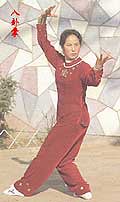more>>More News
- National Day
- ways to integrate into Chinese style life
- Should they be in the same university with me?!!
- Chinese Ping Pang Legend: the Sun Will Never Set
- A Glance of those Funny University Associations
- mahjong----The game of a brand new sexy
- Magpie Festival
- Park Shares Zongzi for Dragon Boat Festival
- Yue Fei —— Great Hero
- Mei Lanfang——Master of Peking Opera
Wonderful Kungfu--- Bagua Zhang
By admin on 2014-12-16
Bagua Zhang or the eight-diagram palm is one of the most popular schools in China. It is also called Youshen Bagua (roving eight-diagram), Longxing Bagua (dragon-shaped eight-diagram), Xingyi Bagua (Xingyi eight-diagram Chuan), Yinyang Bapan Zhang (positive-negative eight-plate palm), etc.
There are different stories about the origin of this school of Chuan. Some say it originated among the anti-Qing Dynasty cliques while others believe that it was created by the two Taoist priests of Bi Yun and Jing Yun on Mount Emei in Sichuan Province during the late Ming Dynasty and early Qing Dynasty and it has been passed down to its ninth generation of practitioners.
Most of Bagua Zhang boxers are found in Hebei Province. Some of them learned Bagua Zhang from scratch from their tutors, while others asked the masters for advice to improve their own skills. Over the years various routines of exercises were cultivated in different styles. The most popular ones are:
The Dong Haichuan-style Bagua Zhang. A native of Zhujiawu, south of Wenan County in Hebei Province, Dong played an important part in the dissemination of the eight-diagram plam, teaching many people in Bei-jing. Most reputed disciples of Dong included Yin Fu, Cheng Tinghua, Liu Fengchun and Li Cunyi who all contributed to the dissemination and development of the Chuan style. Some of the eight-diagram palm styles are named after these disciples, for example the Yin-style, Cheng-style, Liang-style and Sun-style eight-pictography palms.
The Li Zhenqing style of Bagua Zhang or the positive-negative eight-diagram plam Li (a. 1830-1900), a native from Weijiaying in Hebei Province, went to Henan Province to learn the positive-negative eight-diagram palm in order to improve the Chuan techniques which he had already mastered. After returning home in about 1870, Li taught his skills to his villagers. A follower of Li Zhenqing, Ren Zhicheng wrote a book on the Yinyang Bapan Zhang (positive-negative eight-plate palm) in 1937 and the book has been passed down.
The Tian Ruhong style of Bagua Zhang. Tian, whose style of Chuan is called the Yinyang Bagua Zhang (positive-negative eight-diagram palm), was a native of Shandong Province, but later moved to Dengshangu Village at Tanggu in Hebei Province in the late Ming Dynasty. On a tour of Emei and Qingcheng in Sichuan Province, Tian saw wrongdoings and volunteered to do justice. When he was in danger, two Taoist priests rescued him. After the incident, Tian Ruhong acknowledged the priests as his Wushu tutors and followed them for 12 years mastering their style of martial arts. When the Ming Dynasty gave place to the Qing Dynasty, Tian said good-bye to his tutors and returned home. Due to his resentment of the autocracy of the local authorities in the Qing Dynasty, Tian left his home village once again and took with him a youngster called Tian Xuan. Years after, Tian Xuan came back to teach the eight-diagram palm to Tian family members. In the beginning, this style of Chuan was known only among Tian family members. It is only in recent times that it has been taught to others outside of Tian family.
 |
The eight-diagram palm is based on the old Chinese philosophy of eight combinations of three whole and broken lines used in divination. While practising, the practitioner moves according to the eight diagrams. There are eight basic palm plays. A total of 64 palm tricks and moves have come from the original eight basic palm plays. Apart from solo practices, there are also sparrings, Sanshou (free sparring) and fighting with weapons, such as Bagua sword play, Bagua sabre play and Bagua cudgel play, and Bagua play of shaft decorated with seven stars, etc. While practising these routines, practitioners rove around like a dragon moving amidst clouds (see picture).
Bagua Zhang features dexterity and agility. When moving around it is like
walking in a muddy place, with foot steps changing all the time like running
water. Palm tricks and body movements follow one after another. The roving
around looks like endless circles which overlap one another. The body turns
around from the waist during walking, roving, turning, rising and falling. Palm
tricks change with the movements of the body. When the upper body protrudes, the
lower part of the body squats back to keep balance. When the arms are sent out,
the feet are drawn back. When moving it is like a roaming dragon; when squatting
it is like a sitting tiger; when looking around it is like a monkey on the
lookout; when roving it is like a circling eagle.
- Contact Us
-
Tel:
0086-571-88165708
0086-571-88165512E-mail:
admission@cuecc.com
- About Us
- Who We Are What we do Why CUECC How to Apply
- Address
- Study in China TESOL in China
Hangzhou Jiaoyu Science and Technology Co.LTD.
Copyright 2003-2024, All rights reserved




 Chinese
Chinese
 English
English
 Korean
Korean
 Japanese
Japanese
 French
French
 Russian
Russian
 Vietnamese
Vietnamese
